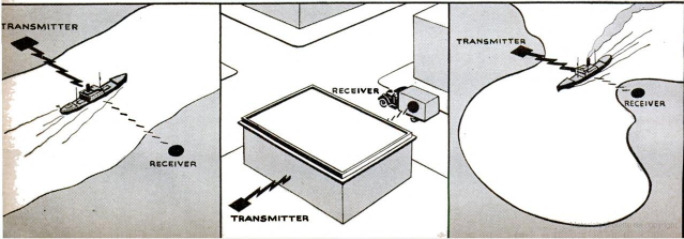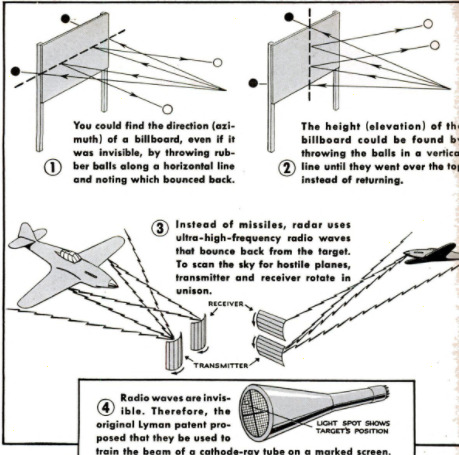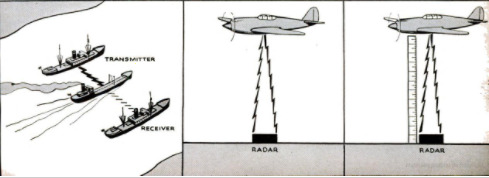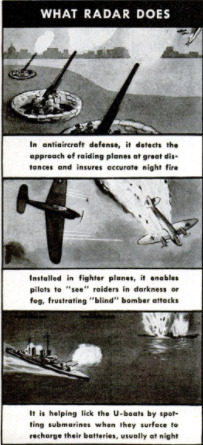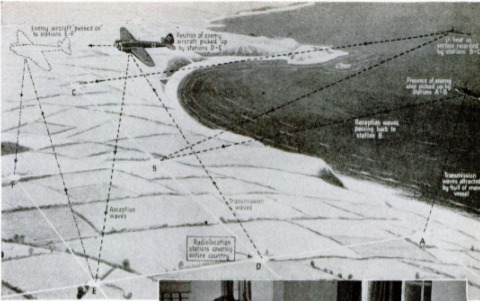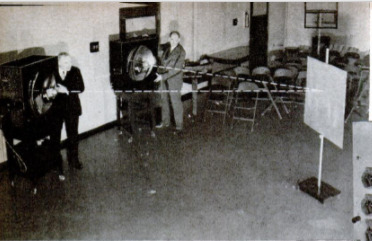-
Title (Dublin Core)
-
The Radar explained
-
Article Title and/or Image Caption (Dublin Core)
-
What are the facts about the Radar?
-
extracted text (Extract Text)
-
TELESCOPE the phrase ‘radio detection
and ranging” into ‘“radar’—and you
have a word that, until recently, was taboo
even to mention. It's the American name for
one of the few basically new weapons of this
war, developed independently in this country
and abroad. Now a joint Army-Navy an-
nouncement has ended the total blackout
surrounding our version of the hush-hush
weapon.
Through fog, storm, or darkness, radar
spots enemy planes and surface ships, for
defense and attack. One of the marvels
made possible by the electron tube, it emits
radio waves of ultrahigh frequency. Re-
flected from a hostile craft, these waves
bounce back to the radar station. Although
they travel at the speed of light, 186,000
miles a second, the extremely short time be-
tween their start and return can be measured
accurately. This interval reveals the distance
of approaching air raiders, or the range of a
naval target. Radar instruments are com-
pact enough to be installed in airplanes, as
well as on land and aboard ships.
The British declare that thelr similar
instrument, which they call the ‘radio
locator” (P.S.M., Oct. 41, p. 82), helped
save England during the aerial blitz of
1940-1941. It warned of distant air raiders
in time for defending planes and antiaircraft
guns to give them a hot reception. Losses of
German planes became 50 heavy that whole-
sale bombing had to be called off.
At sea, radar may prove the weapon
needed to end the U-boat menace, A sub-
marine cannot travel sybmerged for long,
but must surface to recharge its batteries.
Preferably it does so at night, when dark-
ness protects it from observation. But the
magic “eye” of the radar easily spots it.
Equipped with this apparatus, a convoy
escort ship can pump shells into a sub before
it has a chance to dive. This offsets the in-
creased strength of modern submarine hulls,
which are said to withstand the underwater
explosion of a depth charge at a fraction
of the distance that formerly disabled or
destroyed them.
A superdreadnought equipped with radar,
as ours are, can locate an unseen enemy
battleship and drop a broadside upon it.
Radar operates to a distance as great as the
range of the biggest guns. The deadly ac-
curacy with which they are aimed with the
aid of data provided by radar might supple-
ment, if not actually replace, the use of
spotting planes.
Hostile fleets provided with radar will not
meet by accident—as actually happened in
the historic Battle of Jutland. Knowing the
enemy's presence, they may choose whether
to seek or avoid action.
After the war, radar promises new won-
ders. Ships plying dangerous passages will
steer clear of rocks and reefs by radio
echoes, and collisions in fog will be a thing
of the past. Airliners, followed from ground
stations by radar, will be warned by radio
when they are off course. But, right now,
the scientific marvel has more pressing tasks.
Who invented radar first? Both this
country and Britain have a good case, with
Germany—reported to have an inferior type
—a late comer. The British appear to have
started first, while Americans seem to have
obtained practical results sooner.
A Scotch weather man, Robert A. Watson-
Watt, obtained a British patent as long ago
as 1919 upon a device “useful for meteoro-
logical purposes such as the location of
atmospheric electrical discharges.” By doing
this, he hoped to improve radio transmission.
More than a dozen patents subsequently
issued to him dealt with direction finding
for ships and planes. The final result was
the British radio locator. In 1935, Watson-
Watt demonstrated the ability of his first
experimental model to trace the course of a
plane maneuvering overhead and out of
sight, near Daventry, England.
How American radar was developed is
revealed for the first time in
the Army-Navy official re-
port, and in a subsequent
Navy announcement. In
1922, American scientists
discovered that an object
moving in the path of radio
signals interfered with re-
ception. Setting up a receiv-
er on a river bank, they
studied disturbances caused
by passing boats. On land,
they observed similar effects on radio signals
when a receiver in a truck was driven past
large buildings. Couldn't the same principle
be applied for the military purposes of de-
tecting a ship entering a harbor, or passing
between two other vessels at sea? Tests
gave an affirmative answer. But the necessity
of having the transmitter and the receiver
on opposite sides of the “target” limited the
usefulness of the device.
Then, in 1926, came the further discovery
that the surface of an object would reflect
radio waves of high frequency Since the
waves returned to their source, the trans-
mitter and receiver could be installed at the
same place—and our first radar was born.
Research men worked upon it until, in 1930,
they were able to pick up radio “echoes”
from planes passing overhead. The theory
of reflection from moving objects was con-
firmed by experiments conducted in co-
operation with the dirigible Akron.
In January 1931, the U. S. Naval Re-
search Laboratory was assigned the follow=
ing task:
“INVESTIGATE USE OF RADIO TO
DETECT THE PRESENCE OF ENEMY
VESSELS AND AIRCRAFT. SPECIAL
EMPHASIS IS PLACED ON THE CON-
FIDENTIAL NATURE OF THIS PROB-
LEM.”
By this time airplanes in motion nearly
50 miles from the transmitter had been de-
tected under certain conditions. It remained
to measure the distance from the radar to
the plane, a feat accomplished by 1934.
Late in 1938, the first practical shipboard
radar was installed upon the U. S. battleship
New York and given three months of in-
tensive trials at sea. Vice Admiral Alfred
Johnson, commanding the Battleship Divi-
sion, stated, “The equipment is one of the
most important radio. developments since
the advent of radio itselt" No less en
thusiastic are the comments of Army men.
Brig. Gen. Dale D. Hinman, for one, cannot
believe that luck did not play a part when
artillery aided by radar data brought down
Practice targets with aa few a3 14 rounds
of ammunition.
Pioneers of radar development now are
revealed to have included Maj. Gen. Roger
B. Colton, U.S. Army; Commander A. H.
Taylor, U. 8. Navy: and Dr. John H. Del-
linger, of the National Bureau of Standards.
Honors must be shared by the country's
leading electric. and radio’ manufacturers,
Who co-operated wholeheartedly in perfect.
ing radar and getting It nto mass production.
Following the interest aroused by the
Army and Navy reports, makers of U.S.
radar have made public additional details
with Government approval. At the post of
the observer, according to the Western
Electric Company, & cathode tube acts aa
an interpreter and makes reflected signals
visible to the human eye. These signals give
all the information necessary for plotting
the distance, the elevation, and the azimuth,
or horizontal direction, of a plane.
"Westinghouse engineers In 1997 perfected
a “key tube,” said to be the final step in
making early radar practical. This is under-
stood to be the kiystron tube, with which
they demonstrated the power of ultrashort
| waves to light electric lamps at a distance.
It was developed originally at Leland Stan-
ford University by the brothers Russell H.
and Sigurd F. Varian and others. Westing-
house men simplified it, reduced its bulk,
and wucceeded in projecting waves like a
searchlight beam.
In their own field experiments, Westing-
house engineers discovered that highway
traffic disturbed radio transmission between
the company’s works and its research labora
tories u mile away. Each time a car passed
along a highway between the two radio
buildings, the signals rebounded.
The United States has trained many
thousands of men in the operation of radar,
and will train many more thousands, ac-
cording to the General Electric Company.
Early studies of the Heaviside layer, or
“radio roof,” contributed to radar develop-
ment, points out RCA.
“An “echo altimeter” demonstrated by the
Bell Telephone Laboratories some years ago
enables airplanes to avoid mountain-peak
crashes by measuring their height above the
ground, through the reflection of radio
waves, Another predecessor of “modern
radar, it simply applies the principle upside
down, Now It Is the ground station that
finds the helght of the plane.
Tn time of peace, even the friendliest of
‘nations keep such military secrets to them-
solves. But when war came, a British mis-
sion including Watson-Watt' arrived in this
country and placed at our disposal the
plans of the British radio locator. Returning
the favor, we let them know what we had
been doing with radar. Notes were com-
pared. Quite possibly—though this is pure
conjecture—there evolved an Anglo-Ameri-
can radar better
than either had before. Since that time, at
any rate, our radar design has been im-
proved many times.
Results speak louder than theories. In the
South Pacific alone, radar has cost the
enemy millions of dollars’ worth of surface
ships, airplanes, and submarines. One in-
stance of action in this area is cited by
Frank B. McIntosh, director of the radio
and radar division of the War Production
Board:
“In the dead of night an American warship
was scanning the horizon. It detected an
enemy vessel between 20,000 and 30,000
yards away. It fired one salvo. The object
disappeared. Probably the enemy never
knew what hit it.”
In a three-month period of the African
campaign, when radar was used against
Axis night-flying planes, it destroyed 120
of them and also scored 50 to 60 “probables,”
according to Brig. Gen. W. L. Richardson.
Just back from Africa, Gen. Dawson Olm-
stead, Chief Signal Officer of the Army,
confirms the efficacy of American and
British radar equipment there. The air-raid
warning equipment, put into service as
soon as possible after the original landings,
spotted enemy planes at great distances,
Consequently our own air forces could
frequently repel them before they got near
our installations.
Why Germany, reported to have an in-
ferior form of radar, failed to push its
development deserves speculation. To reach
targets within German borders, British
raiders would have to cross a vast expanse
of Europe. Presumably the sound of their
motors could be picked up by acoustic listen-
ing devices of standard design all along the
way, and warning could be flashed ahead to
the target area long before they got there.
What need, then, of radar? Further, Ger-
man reasoning may well have run, the
British must have considered themselves
equally immune, until the sudden fall of
France put German bomber bases right
across the Channel. What could be sweeter
than to swoop in from the sea and rain
destruction upon a city too near the coast
to receive an alarm in time? The surprise
was on the Germans, however, when
Britain's intensively developed radar picked
them up far at sea, and they faced anti-
aircraft guns that were shooting to kill
instead of scattering a random barrage of
flak. Now that Germany is the target, her
radar technicians must be trying desperate-
ly to make up for lost time.
-
Language (Dublin Core)
-
eng
-
Date Issued (Dublin Core)
-
1943-08
-
pages (Bibliographic Ontology)
-
66-70, 214
-
Rights (Dublin Core)
-
Public Domain (Google Digitized)
-
Archived by (Dublin Core)
-
Matteo Ridolfi
-
Marco Bortolami (editor)
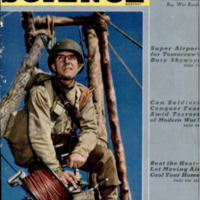 Popular Science Monthly, v. 143, n. 2, 1943
Popular Science Monthly, v. 143, n. 2, 1943

